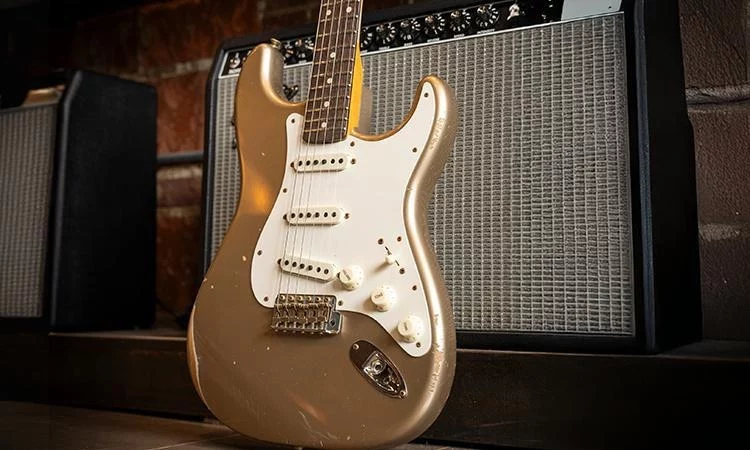Remember when you heard your very first guitar riff that sent shivers up your spine? Maybe it was Hendrix, lighting up Woodstock? Maybe it was Stevie Ray Vaughan playing “Texas Flood.” Or maybe it was that garage band down the corner that used to play loud power chords.
Think about – what were they playing?
Most likely, it was a Fender.
Not only did Fender guitars contribute to the sound of rock and roll, but they helped create the genre itself. From the biting sound of a Telecaster to the croaking sound of a Stratocaster, Fender’s impact remains strong. It’s still alive and kicking.
What’s even better is that the same gear is still out there today, allowing you to make your living room a concert space.
Let’s go back and look into what sets Fender apart and show you how to find that sound.
Born to Rock: The Fender Origin Story
Back in the 1950s, Leo Fender was simply aiming to create something new. He just dreamt of designing something simple, sturdy, and great-sounding for musicians who played for a living.
After that, the Telecaster was released. Clean lines, easy to build, stood strong and played wonderfully. At that time, just having a wooden guitar with 6 strings and an amp was all a guitarist needed to sound like a professional.
The Stratocaster appeared in ’54 and from then on everything changed. Because it had a contoured body, three-pickup setup and a futuristic style, the Strat was an immediate hit.
Buddy Holly brought it to the mainstream. Hendrix set it on fire (literally). Clapton, Gilmour and John Mayer helped shape music history by playing the Strat.
Fender guitars didn’t follow trends. They created them.
More Than Just Looks
Yeah, a Strat looks cool. So does a Jazzmaster, or a Precision Bass. Yet it isn’t only about old style; it’s mostly about the sound.
The way a Fender stands out in a mix is one of its strengths. The glassy top-end, the tight low-end, and the signature “scoop” in between. It is identifiable from the beginning. It’s an icon that anyone recognizes right away. Playing blues, punk, indie, or arena rock styles, it still produces brilliant results.
If you strum softly, your Strat will produce a beautiful sound. Dig in, and it screams.
Its ability to react differently to each player is what sets Fender apart. It feels lively and ready to be used in your hand. This is not a marketing gimmick. That’s 70 years of players plugging in and saying: “Yep. That’s it.”
The Studio and the Stage
Fender’s long-lasting popularity can be attributed to one main reason. Versatility.
Producers find them useful because they blend perfectly in a mix. Players love them because they can go from clean funk to gnarly distortion without skipping a beat.
Even if you’re just jamming at home or recording on your laptop, there is something special about a Strat or Tele that always makes an appearance. They do their job well.
Fender in the Modern Age
Surprisingly, Fender didn’t stop innovating as the years passed. They evolved.
Fender offers a wide variety of guitars today. You can find vintage replicas, new high-tech models, short-scale offsets, and more. It’s possible to get a brand-new guitar with the feel of 1965 but the look of today.
Just in case you ask, do they still have a role? Individuals like John Frusciante, St. Vincent, and H.E.R. are leading Fender’s current growth and popularity.
Let’s Talk Gear (Quickly)
Well, gear heads, here’s all you need to know:
- Telecaster: The tone is snappy, bright and tight. Try to envision country, punk and indie rock.
- Stratocaster: Flat, flexible, and pleasantly expressive. Perfect for blues, funk, pop, and classic rock.
- Jazzmaster/Jaguar: Sounds warmer, quirkier, and is best for genres such as surf, shoegaze, and alternative.
- P-Bass/Jazz Bass: If you’re holding down the low end, these are your go-to legends.
And if you’ve never played a Fender guitar through a clean amp and hit an open E chord, you’re in for a real treat.
Look for One at Your Local Guitar Store
Searching through online forums and watching tutorials for hours is unnecessary. Simply go to a real guitar shop, try out a few models and discover which one suits you.
The feel of the neck, the way the pickups respond, the balance when it’s on your shoulder – all that matters. And these issues often can’t be solved by searching online.
Finding your first guitar or another for your collection is easy if the shop you visit provides good advice. You can find both vintage-style and modern guitars in Fender’s lineup.
Final Chord: The Fender Legacy Lives On
Perfection was never the focus of rock and roll. It focuses on expressing energy, emotion, and rebellion. Fender achieved something magical – and they’ve sustained it over the years.
To make your mark in rock, pick up a Fender guitar, plug it in, and let your music flow.
Come try one out for yourself at Midwood Guitar Studio. We’ve got the classics, the modern builds, and everything in between. Find your sound – because Fender isn’t just a guitar. It’s a legacy.

Lexy Summer is a talented writer with a deep passion for the art of language and storytelling. With a background in editing and content creation, Lexy has honed her skills in crafting clear, engaging, and grammatically flawless writing.



